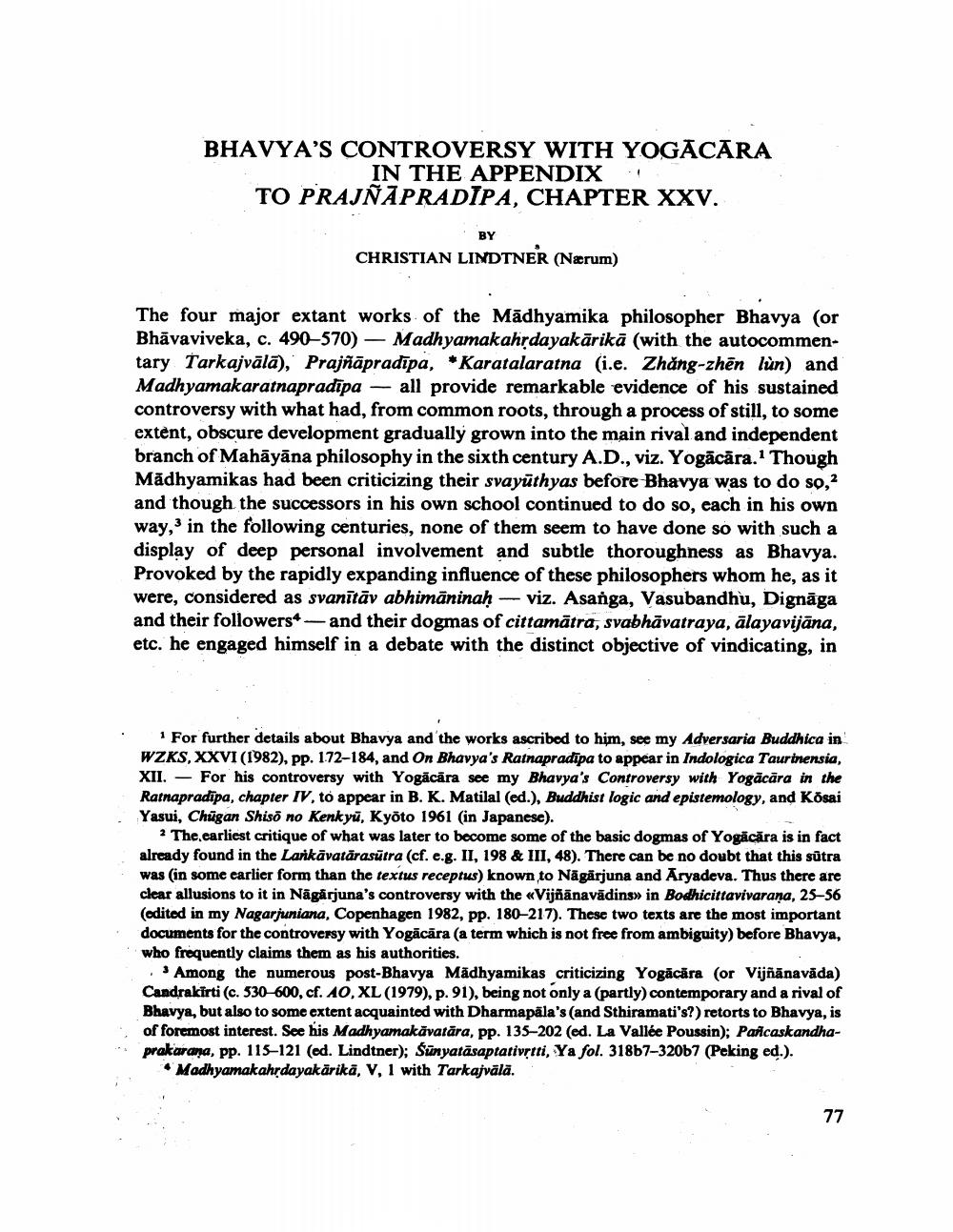________________
BHAVYA'S CONTROVERSY WITH YOGACARA IN THE APPENDIX
TO PRAJNAPRADIPA, CHAPTER XXV.
BY
CHRISTIAN LINDTNER (Nærum)
The four major extant works of the Madhyamika philosopher Bhavya (or Bhāvaviveka, c. 490-570) Madhyamakahṛdayakārikā (with the autocommentary Tarkajvālā), Prajñāpradipa, Karatalaratna (i.e. Zhang-zhen lùn) and Madhyamakaratnapradipa- all provide remarkable evidence of his sustained controversy with what had, from common roots, through a process of still, to some extent, obscure development gradually grown into the main rival and independent branch of Mahāyāna philosophy in the sixth century A.D., viz. Yogācāra.' Though Madhyamikas had been criticizing their svayuthyas before Bhavya was to do so,2 and though the successors in his own school continued to do so, each in his own way,' in the following centuries, none of them seem to have done so with such a display of deep personal involvement and subtle thoroughness as Bhavya. Provoked by the rapidly expanding influence of these philosophers whom he, as it were, considered as svanītāv abhimāninaḥ — viz. Asanga, Vasubandhu, Dignāga and their followers- and their dogmas of cittamätra, svabhāvatraya, ālayavijäna, etc. he engaged himself in a debate with the distinct objective of vindicating, in
1 For further details about Bhavya and the works ascribed to him, see my Adversaria Buddhica in WZKS, XXVI (1982), pp. 1.72-184, and On Bhavya's Ratnapradipa to appear in Indologica Taurinensia, XII. For his controversy with Yogacara see my Bhavya's Controversy with Yogacara in the Ratnapradipa, chapter IV, to appear in B. K. Matilal (ed.), Buddhist logic and epistemology, and Kōsai Yasui, Chugan Shiso no Kenkyu, Kyoto 1961 (in Japanese).
2 The earliest critique of what was later to become some of the basic dogmas of Yogacara is in fact already found in the Lankavatarasutra (cf. e.g. II, 198 & III, 48). There can be no doubt that this sūtra was (in some earlier form than the textus receptus) known to Nagarjuna and Aryadeva. Thus there are clear allusions to it in Nagarjuna's controversy with the «Vijñānavādins» in Bodhicittavivarana, 25-56 (edited in my Nagarjuniana, Copenhagen 1982, pp. 180-217). These two texts are the most important documents for the controversy with Yogacara (a term which is not free from ambiguity) before Bhavya, who frequently claims them as his authorities.
Among the numerous post-Bhavya Madhyamikas criticizing Yogacara (or Vijñānavāda) Candrakirti (c. 530-600, cf. 40, XL (1979), p. 91), being not only a (partly) contemporary and a rival of Bhavya, but also to some extent acquainted with Dharmapala's (and Sthiramati's?) retorts to Bhavya, is of foremost interest. See his Madhyamakāvatāra, pp. 135-202 (ed. La Vallée Poussin); Pañcaskandhaprakarana, pp. 115-121 (ed. Lindtner); Sunyatasaptativṛtti, Ya fol. 318b7-32067 (Peking ed.).
Madhyamakahṛdayakārikā, V, 1 with Tarkajvālā.
77




